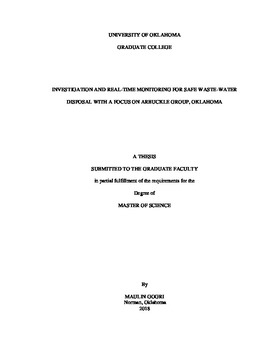| dc.contributor.advisor | Reza, Zulfiquar | |
| dc.contributor.author | Gogri, Maulin | |
| dc.date.accessioned | 2018-01-25T15:21:31Z | |
| dc.date.available | 2018-01-25T15:21:31Z | |
| dc.date.issued | 2018 | |
| dc.identifier.uri | https://hdl.handle.net/11244/54318 | |
| dc.description.abstract | Increase in the earthquakes in the State of Oklahoma in recent years has been tremendous with wastewater disposal considered to be the primary reason behind this increase. A large quantity of wastewater is being injected in the Arbuckle-Group and the connected basement in North Central Oklahoma. Because they are not hydrocarbon-bearing, very little information is available about these formations in the region. Additionally, there is a need to understand the dynamics of wastewater disposal process in order to design safe operational practices with proper monitoring. This thesis attempts to address both of these issues.
A major goal of this study is the characterization of the Arbuckle-Group which has been the primary disposal zones in North Central Oklahoma. To better understand the potential hydraulic coupling between the Arbuckle and underlying basement, an integrated subsurface characterization effort has been undertaken to this front by a team of earth-scientists and petroleum engineers. This thesis emphasizes the engineering aspect of that effort focused on Payne County in North Central Oklahoma. Geophysical, geological, and experimental data from various sources have been acquired, analyzed and employed in the model construction of the disposal zones in this area. Injection volumes, wellhead pressure data and well completion reports from 29 injection wells in the study area are acquired from Oklahoma Corporation Commission. Using a modified-Hall analysis which formed the basis of the work, I constructed a 3D simulation model of the Arbuckle-Group and the underlying basement that defined the lateral distribution, petrophysical properties (including porosity and permeability), and major fault surfaces integrating the available static and dynamic data to characterize the disposal zones, I found the average porosity and permeability of the Arbuckle Group to be around 7% and 10 mD, respectively. The sealing and transmissive nature of a few major faults has been determined as well.
With the help of a suite of reservoir models using Arbuckle-specific data, I devised workflows to better understand the injection well dynamics. Important parameters that affect the disposal process have been identified by a number of Designs of Experiments (DoEs) using relevant uncertain variables and operational parameters. Using modified-Hall analysis I defined normal injection behavior and critically analyzed the safe limits of wastewater disposal operations. A smart and safe disposal-well monitoring scheme is developed based on the learnings, which will help disposal-well management become more economical and environmentally friendly. | en_US |
| dc.language | en_US | en_US |
| dc.subject | Induced Seismicity | en_US |
| dc.subject | Wastewater Disposal Monitoring | en_US |
| dc.subject | Characterization of Arbuckle Group | en_US |
| dc.subject | Modified Hall Analysis | en_US |
| dc.title | INVESTIGATION AND REAL-TIME MONITORING FOR SAFE WASTE-WATER DISPOSAL WITH A FOCUS ON ARBUCKLE GROUP, OKLAHOMA | en_US |
| dc.contributor.committeeMember | Devegowda, Deepak | |
| dc.contributor.committeeMember | Pratner, Matthew | |
| dc.contributor.committeeMember | Marfurt, Kurt | |
| dc.contributor.committeeMember | Fahs, Mashhad | |
| dc.date.manuscript | 2018 | |
| dc.thesis.degree | Master of Science | en_US |
| ou.group | Mewbourne College of Earth and Energy::Mewbourne School of Petroleum and Geological Engineering | en_US |
| shareok.orcid | 0000-0003-3486-335X | en_US |
